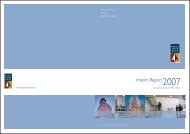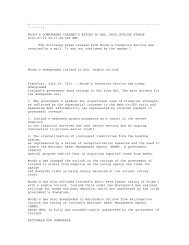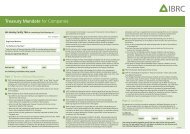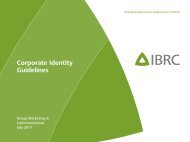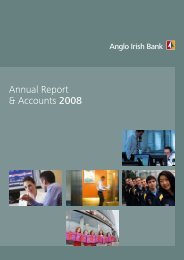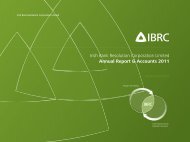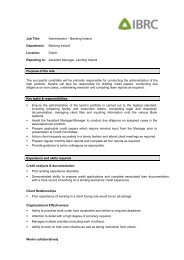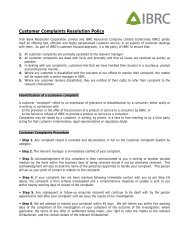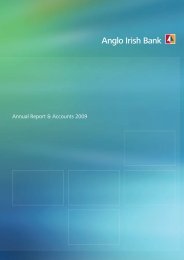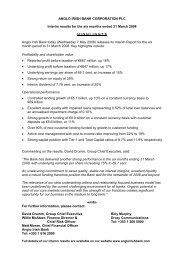IBRC annual report for 2011 - Irish Bank Resolution Corporation ...
IBRC annual report for 2011 - Irish Bank Resolution Corporation ...
IBRC annual report for 2011 - Irish Bank Resolution Corporation ...
You also want an ePaper? Increase the reach of your titles
YUMPU automatically turns print PDFs into web optimized ePapers that Google loves.
Notes to the financial statements continued50. Risk management continuedLiquidity and funding risk continuedThe Group evaluates its longer term liquidity mismatch or structural liquidity risk on a regular basis. The management ofstructural liquidity risk is important in identifying future funding requirements.Risk mitigationIt is accepted that the current liquidity and funding risk position is significantly outside the risk appetite parameters. The <strong>Bank</strong>will continue to manage and monitor this risk, whilst acknowledging that opportunities to reduce it are limited due to thecurrent position of the <strong>Bank</strong>.Holding a portfolio of highly liquid assets has always <strong>for</strong>med part of the Group's liquidity management policy, assisting theGroup in receiving and placing cash in the repo market during periods of market volatility. Given the stressed funding andliquidity position of the <strong>Bank</strong> virtually all of the liquid asset portfolio is currently under repurchase agreements as outlined innote 24.Regulatory liquidityThe Central <strong>Bank</strong> of Ireland introduced regulatory liquidity requirements in 2007, replacing the liquid stock approach with amore advanced cash flow mismatch approach. <strong>Irish</strong> banks are required to <strong>report</strong> coverage in the 0 to 8 day and 9 to 30 dayperiods against which regulatory limits are set with conservative assumptions <strong>for</strong> certain cash flow types. In addition, theCentral <strong>Bank</strong> of Ireland sets qualitative requirements regarded as best practice <strong>for</strong> liquidity risk management.Due to the <strong>Bank</strong>'s reliance on central bank funding, it is not in full compliance with a number of regulatory liquidityrequirements.Market riskDefinitionMarket risk is the risk of a potential adverse change in the Group’s income or financial position arising from movements ininterest rates, exchange rates or other market prices.ObjectiveThe Group aims to have effective systems and methodologies <strong>for</strong> the identification and measurement of market risks in itsbalance sheet. These risks are then managed within strict limits and in the context of a conservative risk appetite level that isconsistent with the support provided to the Group by the <strong>Irish</strong> Government.PoliciesThe Group's exposure to market risk is governed by policies approved by the Risk and Compliance Committee, and overseen byALCO. All risk limits are approved by ALCO and the Risk and Compliance Committee.Strategies and processesThe Group’s Restructuring Plan provides <strong>for</strong> market risk to be minimised in the context of the winding down of the loan bookand the derivatives book. Market risk is managed centrally by the Financial Markets team and GBSM. Market risk throughoutthe Group is measured and monitored by Group Risk, operating independently of the business units.Risk mitigationThe Group has limited ability to engage in risk reducing transactions in the market and there<strong>for</strong>e aims to manage the winddownprocess in a manner that keeps market risk within approved limits.Trading book riskDefinitionThe trading book consists of positions arising from legacy client transactions in a range of financial instruments as well asrelated interbank hedging transactions. It includes interest rate swaps, currency swaps, interest rate futures, <strong>for</strong>ward rateagreements and options. There are no unhedged exposures in equities or commodities.ObjectiveThe Financial Markets team was well advanced at 31 December <strong>2011</strong> in winding down legacy positions in the trading book inaccordance with the Group’s Restructuring Plan. This process will continue in 2012. Management of existing balance sheet riskpositions takes place within a detailed framework of approved limits. The general aim in the reduction of the portfolio is toretain corporate derivatives until the swap matures or until the associated loan is sold/repays and to retain only sufficientinterbank deals to hedge the market risks arising from these retained corporate exposures.126



